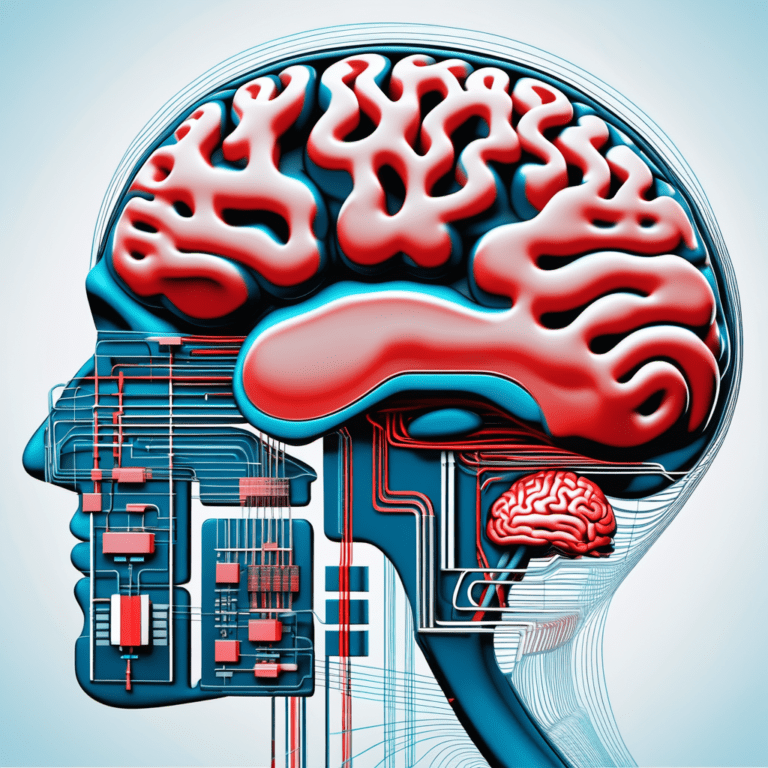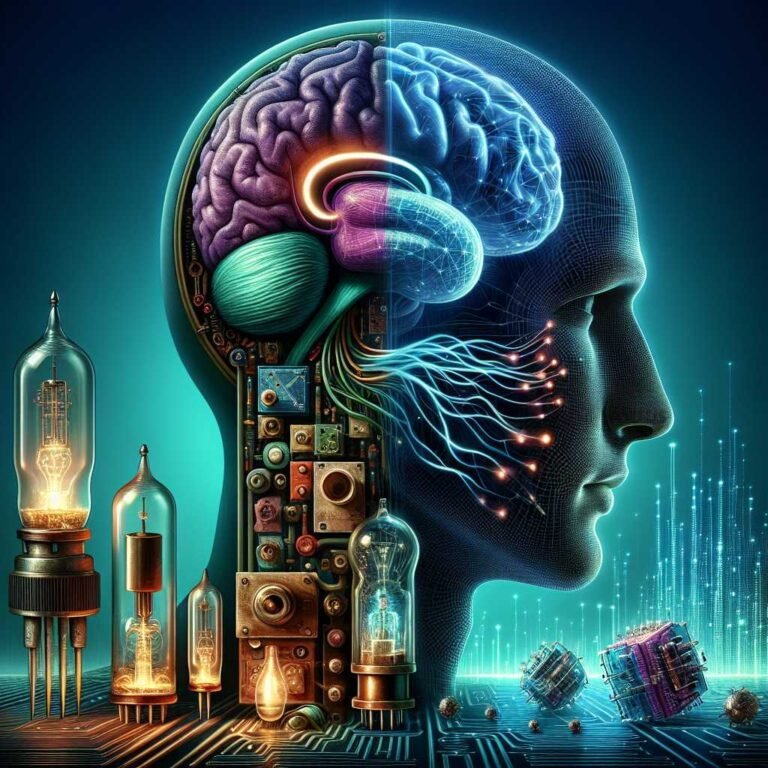Brain-Computer Interfaces (BCIs) Explained: How Minds Connect with Machines
What if you could text with your thoughts, move a cursor with a glance, or restore a lost sense with a tiny implant? Brain-computer interfacing (BCI) sits at the edge of that frontier—turning neural activity into action and feedback. It’s the kind of technology that once lived in science fiction. Now, thanks to rapid advances in neuroscience, engineering, and machine learning, it’s stepping into clinics, labs, and even living rooms.
This guide walks you through what BCIs are, how they work, and where they’re already making a difference. You’ll learn about invasive and noninvasive systems, signal processing basics, real-world uses, and the ethical questions that come with reading and writing neural signals. Whether you’re a student, a builder, or just BCI-curious, consider this your clear, no-jargon introduction to a complex and exciting field.
What Is a Brain-Computer Interface?
A brain-computer interface is a system that measures brain activity and converts it into commands for a computer, robot, or other device. In its simplest form, a BCI reads signals from the brain and translates them into actions—like typing, selecting icons, or moving a robotic arm. More advanced systems are bidirectional: they also send information back into the brain through stimulation, closing the loop between thought and sensation.
Put another way, a BCI is a translator. Your brain speaks in patterns of electrical and chemical activity. A BCI listens, finds meaningful patterns, and maps those to an output. This is a big deal for medicine because it can restore function when normal neural pathways are damaged. It also unlocks new modes of human-computer interaction that don’t rely on muscles or traditional senses. Want to try it yourself? Check it on Amazon.
Regulators and major research efforts are taking BCIs seriously. The U.S. Food and Drug Administration (FDA) maintains guidance on neural interfaces and clinical pathways for BCI devices, including those for paralysis and speech restoration—an invaluable resource if you want to understand safety and translation to the clinic. You can explore it here: FDA on Brain-Computer Interfaces. At the same time, large-scale programs like the NIH BRAIN Initiative fund new tools for recording and stimulating the nervous system.
A Quick Tour of the Brain: Signals You Can Tap
To understand BCIs, it helps to know what signals they read.
- Neurons fire “spikes” (brief electrical impulses) that convey information.
- Groups of neurons generate local field potentials (LFPs), reflecting coordinated activity.
- Electric currents spread through tissue and skull, summing into oscillations we can measure on the scalp.
- Blood flow changes follow neural activity, which we can capture with optical or MRI-based methods.
Different BCI types target different signals:
- EEG (electroencephalography): Measures voltage changes at the scalp. It’s noninvasive, safe, and relatively affordable. EEG captures large-scale brain rhythms (like alpha and gamma bands), which are useful for detecting attention, motor imagery, and event-related potentials (ERPs).
- ECoG (electrocorticography): Measures signals from electrodes placed on the surface of the brain under the skull. It’s more invasive but offers higher signal-to-noise and spatial precision than EEG.
- Intracortical arrays: Penetrating microelectrodes that record spikes from individual neurons or small populations. These offer the richest control signals but require neurosurgery.
- fNIRS and fMRI: Measure hemodynamic responses to neural activity. fNIRS is portable and noninvasive but slower; fMRI is precise but impractical for everyday BCI use.
BCIs can also send information to the brain. Deep brain stimulation (DBS) modulates neural activity to reduce symptoms in conditions like Parkinson’s disease, and cochlear implants turn sound into electrical signals for the auditory nerve. For a clinical overview, see the Mayo Clinic’s DBS primer and the NIDCD’s guide to cochlear implants. Curious what’s available off the shelf? View on Amazon.
How BCIs Work: From Brain Signals to Commands
BCIs follow a pipeline. Once you see it, the field clicks into place.
1) Signal acquisition – Sensors capture brain activity. EEG caps read voltage at the scalp; microelectrodes record spikes; optical sensors track blood flow. Good contact, clean electrodes, and low noise are crucial for usable data.
2) Preprocessing – Raw data is messy. We filter out power-line noise, eye blinks, muscle activity, and other artifacts. In EEG, that often means band-pass filtering and techniques like independent component analysis (ICA).
3) Feature extraction – From the cleaned signal, we compute features that capture information. Examples include band-power in specific frequency ranges, time-locked ERP amplitudes (e.g., P300), spatial filters (like Common Spatial Patterns), or spike firing rates.
4) Machine learning and decoding – Models map features to outputs. Traditional classifiers (LDA, SVM) and modern deep learning (CNNs, RNNs) can work well, especially with subject-specific training. Online learning helps the decoder adapt over time.
5) Feedback and control – The user sees or feels the system’s response, learns to modulate their brain activity, and improves performance. In bidirectional systems, stimulation provides sensory feedback or therapeutic modulation.
You’ve likely heard of “P300 spellers,” where flashing letters evoke an ERP that lets users select characters. SSVEP-based systems use flickering targets to produce strong frequency responses, enabling robust selection with minimal training. Motor imagery BCIs translate imagined movement into commands for cursors or exoskeletons. For deeper reading, check this technical overview in Frontiers in Neuroscience and broader coverage from IEEE Spectrum.
Types of BCIs: Invasive, Semi-Invasive, Noninvasive, and Bidirectional
BCIs vary by how they access the brain and whether they both read and write signals.
- Noninvasive BCIs (EEG, fNIRS):
- Pros: Safe, portable, relatively affordable, widely used in research and education.
- Cons: Lower spatial resolution; signals must pass through skull and scalp; more noise; often slower information rates.
- Use cases: Communication (P300 spellers), rehab training, attention and alertness monitoring, gaming and art.
- Semi-invasive BCIs (ECoG):
- Pros: Stronger signals and better spatial resolution than EEG; stable over longer periods.
- Cons: Requires surgery; usually limited to clinical contexts (e.g., epilepsy monitoring).
- Use cases: Speech decoding, high-performance movement control, research devices.
- Invasive BCIs (intracortical arrays):
- Pros: Highest-resolution signals; fine-grained control of prosthetic limbs; potential for rich bidirectional interfaces.
- Cons: Surgery risks, long-term stability and biocompatibility challenges.
- Use cases: Restoring movement and touch; advanced research prototypes.
- Stimulating and bidirectional BCIs:
- Examples include cochlear implants, retinal implants, DBS, and closed-loop systems that both sense and stimulate to maintain desired brain states.
- The frontier: Somatosensory feedback in prosthetics and adaptive, closed-loop neuromodulation.
Defense and research agencies are also exploring non-surgical, high-bandwidth approaches, like DARPA’s Next-Generation Nonsurgical Neurotechnology (N3). Ready to upgrade your neurotech reading list? Buy on Amazon.
Where BCIs Are Used Today
We’re past the demo stage in many areas. Here are the applications moving fastest.
- Restoring communication
- BCIs can help people with ALS or spinal cord injury type with thoughts, either via spellers or direct speech decoding from cortical activity. Accuracy improves with training and personalized models.
- Motor function and prosthetics
- Intracortical BCIs have enabled users to control robotic arms, grasp objects, and even receive touch feedback via cortical stimulation. While still in research, the path to practical systems is accelerating.
- Sensory restoration
- Cochlear implants are a mainstream success, with hundreds of thousands of users worldwide. Retinal implants exist but remain limited compared to natural vision.
- Therapy and neuromodulation
- Closed-loop DBS adjusts stimulation in real time based on neural signatures, improving outcomes in movement disorders. Similar ideas are being tested for depression and epilepsy.
- Education, gaming, and wellness
- Noninvasive BCIs offer attention tracking, basic control signals for games, and meditative feedback. These are not medical devices and results vary, but they’re powerful for learning and prototyping.
- Safety and alertness monitoring
- EEG can detect drowsiness or lapses in attention, useful in high-risk jobs or long-haul driving. Real-world deployment requires robust, artifact-tolerant designs.
A helpful mindset: BCIs succeed when they solve a specific problem for a specific user in a specific context. The more focused the use case, the better the experience.
Getting Started as a Student or Builder: Tools, Specs, and Buying Tips
If you’re new and want to experiment, start noninvasively. EEG headsets, open-source toolchains, and public datasets make it easier than ever to learn.
Key hardware considerations for consumer/research EEG: – Channels: More electrodes capture more spatial detail. For learning, 8–16 channels can go far. For research-grade work, 32+ channels are common. – Sampling rate: 250–500 Hz handles most BCI tasks; higher rates can help for fast ERPs or advanced analyses. – Electrodes: Dry sensors are convenient but can be noisy; wet or semi-dry improve signal quality at the cost of setup time. – Latency and jitter: Real-time BCIs need stable timing. Check end-to-end latency, not just sampling rate. – Comfort and fit: A cap that fits poorly is a cap you won’t use. Weight, clamp pressure, and cable management matter. – Regulatory marks: Look for CE/FCC compliance and clear safety documentation. Compare options here: See price on Amazon.
Software you’ll meet early and often: – MNE-Python for EEG/MEG signal processing and visualization: MNE. – BCI2000, a modular platform for data acquisition and real-time BCI: BCI2000. – Lab Streaming Layer for synchronized data streams: LSL. – Machine learning in Python: scikit-learn for classical approaches; PyTorch or TensorFlow for deep learning.
Datasets to practice with: – PhysioNet’s EEG Motor Movement/Imagery dataset: PhysioNet EEG MM/MI. – BCI Competition IV datasets for benchmarking algorithms: BCI Competition IV.
Practical tips: – Start with a clear task (e.g., detect eye-blink ERPs or classify motor imagery between left vs. right hand). – Build a minimal real-time loop early, even if accuracy is low. Feeling the latency and feedback is instructive. – Record your own calibration data and annotate carefully. Good labels beat clever algorithms. – Expect artifacts. Design paradigms that minimize head and jaw motion, and use grounding and shielding where possible. – Keep sessions short and take breaks. Cognitive fatigue is real and will tank accuracy.
One more thing: don’t confuse medical devices with consumer headsets. If you’re interested in clinical use, read up on risk, consent, and regulatory pathways via the FDA. Curious what starter kits and textbooks people actually use? Support our work by shopping here: Shop on Amazon.
Ethics, Privacy, and Safety: What’s at Stake
BCIs surface profound questions because they touch identity, agency, and autonomy. Here’s what to consider:
- Informed consent and vulnerability
- Users may face risks or pressures (medical, economic, or social). Consent must be ongoing, understandable, and revocable.
- Data rights and privacy
- Neural data can be intimate. Who owns it? Who can share it? Strong defaults favor user ownership and encryption.
- Security and misuse
- As with any connected device, BCIs can be attacked. Threat models should include data theft, manipulation, and system hijacking.
- Bias and fairness
- Decoders trained on narrow populations can underperform for others. Diverse datasets and continuous monitoring for bias are essential.
- Enhancement and equity
- As augmentative systems improve, access and fairness matter. We should avoid creating new forms of exclusion.
For policy context, see the OECD Recommendation on Responsible Innovation in Neurotechnology and the Nuffield Council on Bioethics’ work on neurotechnology. Here’s why that matters: ethical guardrails build trust, and trust drives adoption.
Limits Today and What’s Next
It’s easy to overpromise. Let’s stay clear-eyed about what works and what’s still hard.
Current limits: – Signal quality and stability – Noninvasive signals are weak and noisy. Even invasive arrays can lose signal over months to years. – Calibration and generalization – Many systems require per-user training and frequent recalibration. Performance can drop across sessions or contexts. – Usability – Headsets can be uncomfortable. Gel is messy. Home use needs fast setup, sturdy hardware, and forgiving software. – Real-world robustness – Movement, sweat, environment noise, and multitasking all degrade performance outside the lab.
Near-future progress to watch: – Better sensors and materials – Dry or semi-dry electrodes that approach gel-quality. Flexible, skin-friendly materials. Improved contact stability. – Smarter decoders – Self-supervised and transfer learning for fast onboarding. On-device models that adapt in real time. – Hybrid systems – Combining EEG with eye tracking, EMG, or inertial sensors for richer control and more robustness. – Closed-loop therapeutics – Personalized, adaptive neuromodulation for movement disorders, pain, depression, and more—measuring and modulating in one loop.
Non-surgical, high-bandwidth interfaces remain a moonshot, but cross-pollination from optics, ultrasound, and materials science is promising. Ready to browse what’s out there today and see how fast the field is moving? Ready to upgrade your neurotech reading list? Buy on Amazon.
Key Takeaways
- A BCI is a translator between neural activity and external devices. The most effective systems focus on specific, well-defined tasks.
- Noninvasive EEG is the easiest entry point for learning and prototyping. Better signals, smarter models, and careful design beat hype.
- Bidirectional BCIs—reading and writing the brain—are here in the form of cochlear implants and DBS, with richer sensory feedback on the horizon.
- Ethics isn’t an afterthought. Privacy, consent, safety, and fairness must be built into every layer of the stack.
If this piqued your curiosity, keep learning: follow FDA guidance for clinical insight, explore open-source tools, and read leading reviews. And if you want more deep-dives like this, subscribe or check back—we publish practical, human-first explainers on emerging neurotech.
FAQ: Brain-Computer Interface Basics
Are BCIs safe?
Noninvasive BCIs like EEG are considered safe and are used widely in research and wellness contexts. Invasive BCIs, including ECoG and intracortical implants, involve surgery and carry associated risks (infection, scarring, hardware failure). Clinical systems go through strict regulatory review; see the FDA’s BCI page for details.
Can BCIs read my thoughts?
No. Current BCIs decode specific patterns tied to tasks (e.g., focusing on a flashing letter, imagining moving your hand). They don’t extract private thoughts or complex intentions. Decoding improves with training, controlled paradigms, and user cooperation.
How accurate are noninvasive BCIs?
It depends on the task, training, and environment. SSVEP and P300 spellers can achieve high accuracy with careful setup, while motor imagery often needs more practice and personalized features. Expect a learning curve and plan for calibration.
How much do BCIs cost?
Consumer EEG headsets range from a few hundred to a few thousand dollars. Research-grade systems (more channels, better amplifiers) can cost much more. Software is often free and open-source, but research licenses for MATLAB or advanced toolkits may add costs.
What skills do I need to build a BCI?
Basic signal processing, machine learning, and a bit of neuroscience. Comfort with Python (or MATLAB) helps. Start by analyzing public datasets and building simple real-time demos; then layer on complexity.
Are BCIs only for medicine?
No. While clinical applications are transformative, BCIs also enable accessibility tools, gaming, education, art installations, and alertness monitoring. That said, set expectations: consumer systems have limits compared to clinical devices.
What’s the difference between EEG and ECoG?
EEG sits on the scalp, is noninvasive, and captures broad rhythms with lower spatial precision. ECoG sits on the brain’s surface under the skull, requires surgery, and offers stronger, more localized signals.
How long does it take to learn to control a BCI?
Some paradigms (like SSVEP) work almost immediately. Others (like motor imagery) may take hours to days of practice and iterative decoder tuning. Short, focused sessions and clear feedback help a lot.
Where can I find datasets to practice?
Start with PhysioNet EEG MM/MI and BCI Competition IV. They’re widely used, well-documented, and great for benchmarking your pipeline.
Discover more at InnoVirtuoso.com
I would love some feedback on my writing so if you have any, please don’t hesitate to leave a comment around here or in any platforms that is convenient for you.
For more on tech and other topics, explore InnoVirtuoso.com anytime. Subscribe to my newsletter and join our growing community—we’ll create something magical together. I promise, it’ll never be boring!
Stay updated with the latest news—subscribe to our newsletter today!
Thank you all—wishing you an amazing day ahead!
Read more related Articles at InnoVirtuoso
- How to Completely Turn Off Google AI on Your Android Phone
- The Best AI Jokes of the Month: February Edition
- Introducing SpoofDPI: Bypassing Deep Packet Inspection
- Getting Started with shadps4: Your Guide to the PlayStation 4 Emulator
- Sophos Pricing in 2025: A Guide to Intercept X Endpoint Protection
- The Essential Requirements for Augmented Reality: A Comprehensive Guide
- Harvard: A Legacy of Achievements and a Path Towards the Future
- Unlocking the Secrets of Prompt Engineering: 5 Must-Read Books That Will Revolutionize You







